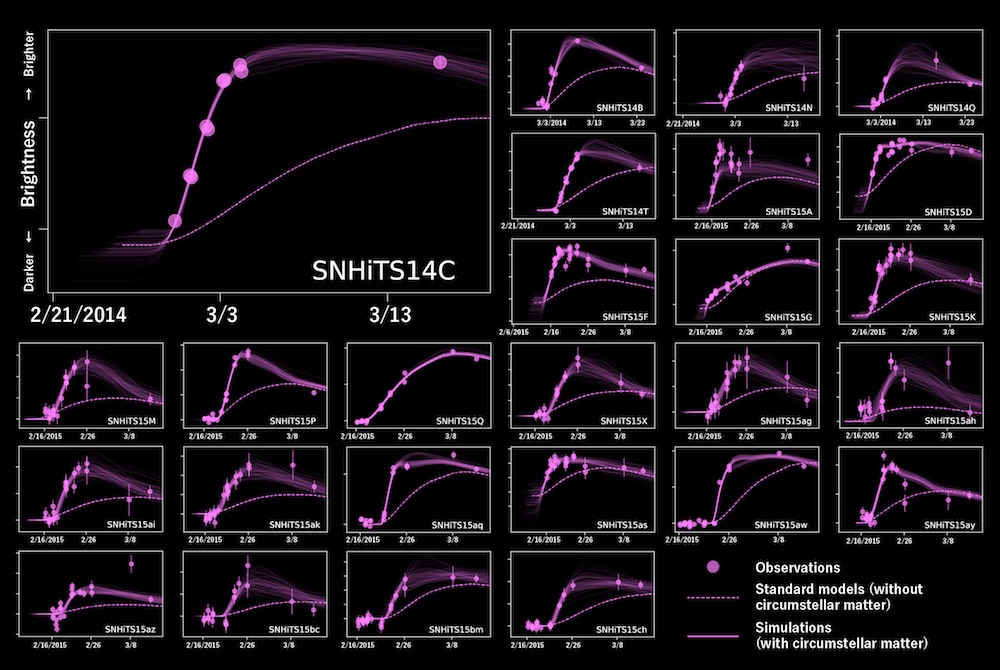
|
|
Fig 1:
Artist's impression of a red supergiant surrounded with thick circumstellar matter. (Credit: NAOJ) [1920x1920 color, JPG (828 KB)] [3200x3200 color, JPG (1.9 MB)] [1920x1920 gray, JPG (737 KB)] [3200x3200 gray, JPG (1.9 MB)] |
At the end of its life, a red supergiant star explodes in a hydrogen-rich supernova. By comparing observation results to simulation models, an international research team found that in many cases this explosion takes place inside a thick cloud of circumstellar matter shrouding the star. This result completely changes our understanding of the last stage of stellar evolution.

|
|
Fig 1:
Artist's impression of a red supergiant surrounded with thick circumstellar matter. (Credit: NAOJ) [1920x1920 color, JPG (828 KB)] [3200x3200 color, JPG (1.9 MB)] [1920x1920 gray, JPG (737 KB)] [3200x3200 gray, JPG (1.9 MB)] |
The research team led by Francisco Förster at the University of Chile used the Blanco Telescope to find 26 supernovae coming from red supergiants. Their goal was to study the shock breakout, a brief flash of light preceding the main supernova explosion. But they could not find any signs of this phenomenon. On the other hand, 24 of the supernovae brightened faster than expected.
To solve this mystery, Takashi Moriya at the National Astronomical Observatory of Japan (NAOJ) simulated 518 models of supernovae brightness variations and compared them with the observational results. The team found that models with a layer of circumstellar matter about 10% the mass of the Sun surrounding the supernovae matched the observations well. This circumstellar matter hides the shock breakout, trapping its light. The subsequent collision between the supernova ejecta and the circumstellar matter creates a strong shock wave that produces extra light, causing it to brighten more quickly.

|
|
Fig 2:
The 26 detected supernovae light curves (points), compared to standard models (dashed lines), and simulations in this study (continuous lines). Most of the supernovae rise up faster than the standard models and match the simulation results very well. (Credit: Förster et al. Nature Astronomy 2018, modified) [2417x1620 black, JPG (1.5 MB)] [2417x1620 white, JPG (1.5 MB)] |
Moriya explains, “Near the end of its life, some mechanism in the star's interior must cause it to shed mass that then forms a layer around the star. We don't yet have a clear idea of the mechanism causing this mass loss. Further study is needed to get a better understanding of the mass loss mechanism. This will also be important in revealing the supernova explosion mechanism and the origin of the diversity in supernovae.”
These observations were performed by the Blanco Telescope at Cerro Tololo Inter-American Observatory during six nights in 2014 and eight nights in 2015. The simulations by Moriya were performed on the NAOJ Center for Computational Astrophysics PC cluster. This research was published in Nature Astronomy on September 3, 2018.
Title: "The delay of shock breakout due to circumstellar material evident in most type II supernovae"
Journal: Nature Astronomy
DOI: 10.1038/s41550-018-0563-4
Authors: F. Förster, T. J. Moriya, J.C. Maureira, J.P. Anderson, S. Blinnikov, F. Bufano, G. Cabrera–Vives, A. Clocchiatti, Th. de Jaeger, P.A. Estévez, L. Galbany, S. González– Gaitán, G. Gräfener, M. Hamuy, E. Hsiao, P. Huentelemu, P. Huijse, H. Kuncarayakti, J. Martínez, G. Medina, F. Olivares E., G. Pignata, A. Razza, I. Reyes, J. San Martín, R.C. Smith, E. Vera, A.K. Vivas, A. de Ugarte Postigo, S.-C. Yoon, C. Ashall, M. Fraser, A. Gal–Yam, E. Kankare, L. Le Guillou, P.A. Mazzali, N.A. Walton, D.R. Young
This research is supported by the Grants-in-Aid for Scientific Rsearch of the Japan Society for the Promotion of Science (No. 16H07413, 17H02864).
Related Links
Center for Computational Astrophysics, NAOJ Press Release "Veiled Supernovae Provide Clue to Stellar Evolution"
NAOJ Press Release "Veiled Supernovae Provide Clue to Stellar Evolution"
The University of Chile Press Release "Chilean scientists discover crucial event right before the death of a star"
Takashi Moriya Personal Webpage